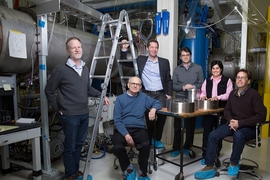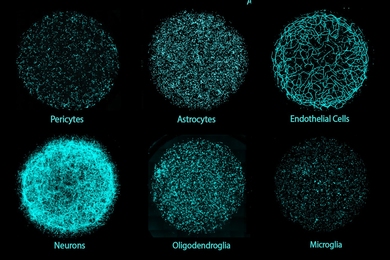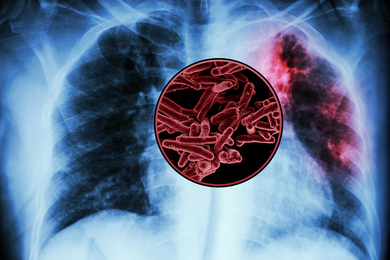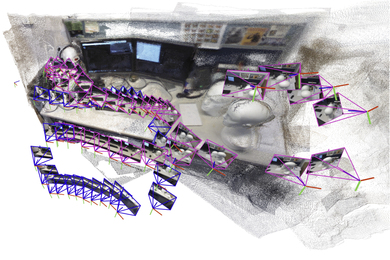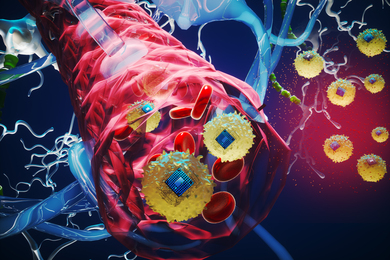Minutes before dawn on Sept. 14, 2015, the Laser Interferometer Gravitational-wave Observatory (LIGO) became the first-ever instrument on Earth to directly detect a gravitational wave. This work, led by the LIGO Scientific Collaboration with prominent roles from MIT and Caltech, was the first confirmation of this consequence of Albert Einstein’s theory of general relativity — 100 years after he first predicted it. The groundbreaking detection represented an enormous step forward in the field of astrophysics. In the years since, scientists have striven to achieve even greater sensitivity in the LIGO detectors.
New research has taken investigators one step closer to this goal. Nergis Mavalvala, the Curtis and Kathleen Marble Professor of Astrophysics at MIT, postdoc Robert Lanza, graduate student Nancy Aggarwal, and their collaborators at Louisiana State University (LSU) recently conducted experiments that could help overcome a future limitation in Advanced LIGO. In their laboratory study, the team successfully measured a type of noise that will soon hold the LIGO instruments back from detecting gravitational waves with greater sensitivity.
Their study, reported recently in Nature, was the first to measure an important source of quantum noise at room temperature and at frequencies relevant to gravitational wave detectors. Funded by the National Science Foundation, this work could enable researchers to understand this limiting noise source and test ideas for circumventing it to further increase LIGO’s sensitivity to gravitational waves.
In addition to future applications for improving LIGO’s detection abilities, Mavalvala says these observations of quantum effects at room temperature could help scientists learn more about how quantum mechanics can disturb the precision of measurements generally — and how best to get around these quantum noise limits.
“This result was important for the gravitational wave community,” says Mavalvala. “But more broadly, this is essentially a room-temperature quantum resource, and that's something that many communities should care about.”
Sensitivity upgrade
LIGO has undergone upgrades since its first gravitational wave searches in 2002; the currently operating version of the instrumentation is called Advanced LIGO following major upgrades in 2015. But to get LIGO to its maximum design sensitivity, Mavalvala says her team needs to be able to conduct experiments and test improvement strategies in the laboratory rather than on the LIGO instruments themselves. LIGO’s astrophysical detection work is too important to interfere with, so she and her collaborators have developed instruments in the lab that can mimic the sensitivity of the real thing. In this case, the team aimed to reproduce processes that occur in LIGO to measure a type of noise called quantum radiation pressure noise (QRPN).
In LIGO, gravitational waves are detected by using lasers to probe the motion of mirrors. The mirrors are suspended as pendulums, allowing them to have periodic motion similar to a mass on a spring. When laser beams hit the movable mirrors, the momentum carried by the light applies pressure on the mirror and causes them to move slightly.
“I like to think of it like a pool table,” says Aggarwal. “When your white cue ball strikes the ball in front of it, the cue ball comes back but it still moves the other ball. When a photon that was traveling forward then travels backwards, the momentum went somewhere; [in this case] that momentum went into the mirror.”
The quantum nature of light, which is made up of photons, dictates that there are quantum fluctuations in the number of photons hitting the mirrors, creating an uncertain amount of force on the mirrors at any given moment. This uncertainty results in random perturbations of the mirror. When the laser power is high enough, this QRPN can interfere with gravitational wave detection. At Advanced LIGO’s full design sensitivity, with many hundreds of kilowatts of laser power hitting 40-kilogram mirrors, QRPN will become a dominant limitation.
Minuscule mirrors
To address this imminent issue, Mavalvala, Aggarwal, and their collaborators designed an experiment to recreate the effects of QRPN in a laboratory setting. One challenge was that the team could not use lasers as powerful as those in Advanced LIGO in their lab experiments. The greater the laser power and the lighter the mass of the mirror oscillator, the stronger the radiation pressure-driven motion. To be able to detect this motion with less laser power, they needed to create an extremely low-mass mirror oscillator. They scaled down the 40-kilogram mirrors of Advanced LIGO with a 100-nanogram mirror oscillator (less than the mass of a grain of salt).
The team also faced the significant challenge of designing a mirror oscillator that could exhibit quantum behavior at room temperature. Previously, observing quantum effects like QRPN required cryogenic cooling so that the motion due to heat energy of the oscillator would not mask the QRPN. In addition to being challenging and impractical, vibrations associated with cryogenic cooling interferes with LIGO’s operation, so conducting experiments at room temperature would be more readily applicable to LIGO itself. After many iterations of design and testing, Mavalvala and her MIT colleagues designed a mirror oscillator that allowed the team to reach a low enough level of thermally driven fluctuations that the mirror motion was dominated by QRPN at room temperature — the first-ever study to do so.
“It’s really pretty mind-boggling that we can observe this room-temperature, macroscopic object — you can see it with the naked eye if you squint enough — being pushed around by quantum fluctuations,” Mavalvala says. “Its thermal jitter is small enough that it’s being tickled ever-so-slightly by quantum fluctuations, and we can measure that.”
This was also the first study to detect QRPN at frequencies relevant to gravitational wave detectors. Their success means that they can now design additional experiments that reflect the radiation pressure conditions in Advanced LIGO itself.
“This experiment mimics an important noise source in Advanced LIGO,” says Mavalvala. “It's now a test bed where we can try out new ideas for improving Advanced LIGO without impinging on the instrument’s own operating time.”
Advanced LIGO does not yet run its lasers at strong enough power for QRPN to be a limiting factor in gravitational wave detections. But, as the instruments become more sensitive, this type of noise will soon become a problem and limit Advanced LIGO’s capabilities. When Mavalvala and her collaborators recognized QRPN as an imminent issue, they strove to recreate its effects in the laboratory so that they can start exploring ways to overcome this challenge.
“We've known for a long time that this QRPN would be a limitation for Advanced LIGO,” says Mavalvala. “Now that we are able to reproduce that effect in a laboratory setting, we can start to test ideas for how to improve that limit.”
Mavalvala’s primary collaborator at LSU was Thomas Corbitt, an associate professor of physics and astronomy. Corbitt was formerly a graduate student and post-doctoral scholar in Mavalvala’s lab at MIT. They have since collaborated for many years.
“This is the first time this effect has been observed in a system similar to gravitational wave interferometers and in LIGO’s frequency band,” says Corbitt. “While this work was motivated by the imperative to make ever-more-sensitive gravitational wave detectors, it is of wide interest.”
New directions
Since the original detection of a binary black hole merger in 2015, LIGO has also captured signals from collisions of neutron stars, as well as additional black hole collisions. These waves ripple outward from interactions that can take place more than a billion light years away. While LIGO’s capabilities are impressive, Mavalvala and her team plan to continue finding ways to make LIGO even more powerful.
Before they collide, black holes, for example, orbit each other slowly and at lower frequencies. As the two black holes get closer, their orbits speed up and they swirl around each other at high speeds and high frequencies. If Advanced LIGO becomes sensitive enough to pick up lower frequencies, Mavalvala says we may someday detect these systems earlier in the process, before the pair collides, allowing us to draw an ever-clearer picture of these distant spacetime phenomena. She and her team aim to make sure that factors such as QRPN don’t limit Advanced LIGO’s growing power.
“At this moment in time, Advanced LIGO is the best it can be at its job: to look out at the sky and detect gravitational wave events,” says Mavalvala. “In parallel, we have all of these ideas for making it better, and we have to be able to try those out in laboratories. This measurement allows that to happen with QRPN for the first time.”


